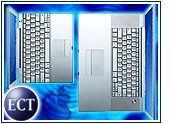
This week brought the latest piece of evidence that Intel, despite ruling the PC microprocessor race, cannot be all things to all parts of the chip business. The company is closing its custom chip manufacturing division, which for the last 18 months has produced application specific integrated circuits (ASICs) — specially designed circuits used in networking equipment and other non-PC computing devices. IBM, Intel’s archrival in the chip business, is the leader in this area, reaping about US$2.7 billion in revenue last year.
Intel’s move is not, in itself, remarkable. The company has often retreated from businesses it found no longer could support margins or strategic directions. The most notable example was the company’s cession of the dynamic random access memory market to Asian chip giants in the ’80s, as it switched to focusing almost exclusively on CPUs.
Now, however, amid renewed competition from rivals AMD and Transmeta, sluggish sales of PCs and skyrocketing Pentium speeds for which no mortal can find a use, it is tempting to view any retreat as a capitulation. With the tech world focused on buying less costly gear, is the world’s foremost chipmaker in the twilight of its reign? Intel has not stopped perfecting its products, but the business case for the company’s microprocessors is harder to muster than it once was.
Many Ways To Skin a Cat
Intel has not lost its chipmaking edge, but a phenomenon of diminishing returns may be forcing the company to make difficult choices. InStat/MDR chip analyst Thomas Halfhill told the E-Commerce Times that as each new chip ships with a higher clock speed, Intel struggles to bridge the widening performance gap between chip speed and other, slower parts of the PC, such as disk and memory. “They’re still getting improved performance with each new chip, but they need to work harder to come up with things like faster front side buses or cache memory,” Halfhill said.
The front side bus — the wires that connect the processor to memory — has been boosted to 800 MHz in newer Pentiums, and cache memory on the latest mobile chip, the Pentium-M, was increased from the 512 KB standard on many processors to 1 MB. Both improvements are meant to compensate for slower memory that has not kept pace with performance increases of the processor itself.
The problem for Intel, as a master of manufacturing technology, is that each new generation of chips that follows Moore’s Law contains more transistors, challenging the company to find ways to use those transistors to increase performance. “These chips get more and more complex,” said Halfhill, citing as an example a recent halt in shipment of new Pentiums, which occurred because of a bug in production of the new, faster front side bus.
Better Not Good Enough
But although there are physical limits to the kinds of chips Intel will be able to develop, this is not the company’s most pressing problem. Transistors on a chip cannot be smaller than the diameter of an atom, generally considered one one-hundredth of a nanometer. But chips are just moving into the 90-nanometer range, and Intel has invested in advanced technologies, such as extreme ultraviolet lithography, that will keep it busy in the nanometer range through the next decade.
What truly haunts Intel and rouses skeptics is not the technical aspect of chipmaking, but rather the fact that high-performance chips are no longer worth the premium price they once commanded. “Performance isn’t what it used to be,” IDC chip analyst Shane Rau told the E-Commerce Times, blaming the absence of a killer application for the lackluster appeal of performance increases.
Rau’s argument is at the core of a widely held notion known as “good enough computing,” which suggests that Intel’s continued investment in advanced semiconductor lithography is, in some sense, a waste. Good enough computing has gained sufficient traction to become received wisdom in some circles.
In a presentation to Merrill Lynch investors in February 2003, chip analyst and Dynamic Silicon Newsletter editor Nick Tredennick opined that Moore’s Law and the thrill of higher clock speeds no longer drive the market because “the PC’s performance is now good enough to satisfy most of its customers.” Instead, Tredennick predicted that growing use of laptop, handheld and portable computers would shift the focus to chips that offer better performance per dollar per watt of electricity. Faster chips made from more expensive tools may not fit that bill.
Damn the Torpedos
But even if it is scared of good enough computing, Intel is not blinking. The company has redoubled its efforts to try to be all things, hoping to hedge its bets on which way consumers will go. IDC’s Rau said the chip giant has done a good job of differentiating its chips in the mobile market with the Centrino platform, which integrates wireless technology and touts low power consumption. Now, he added, the same must be done for the desktop.
“‘What is the value proposition of the desktop computer?’ is the question Intel and others have to answer,” he said, noting that the features included with new chips have become just as important as raw performance. One qualitative innovation is Intel’s hyperthreading technology, which processes instructions in parallel. Rau pointed out that hyperthreading relies on changes to both the processor and the chips that support it — the chipset — making it a platform innovation rather than merely a speed upgrade.
Itanium Game Not Over
At the same time that it is shifting its marketing message with Centrino, however, Intel keeps pushing performance limits with the Itanium chip, which has demonstrated impressive server and workstation processing benchmarks. It is still too early to say whether the chip ultimately will flop or not, but it is off to a slow start — Gartner predicts only $200 million worth of Itanium chips will be sold this year. In contrast, Intel averages $5 billion per quarter in sales of Pentium 4 and other chips.
Gartner director of research John Enck told the E-Commerce Times that Itanium sales likely will not reach $1 billion before 2005. “There just isn’t a killer app yet,” he said. Indeed, Intel has been slow to find the right niche for the expensive chip in a market drawn more and more to “blades” — inexpensive, modular servers that can be built with parts made by Intel competitors Transmeta and AMD.
The Itanium struggle may be the best indicator that Intel itself is the strongest believer in its continued relevance to the industry, for it appears there is no amount of money the company will not spend to keep churning out the expensive chip. “There’s no way Intel will drop Itanium. It’s a matter of pride for them,” Enck said. After all, Intel has said Itanium will take over high-end, multiprocessor computing, and its reputation is at stake in proving this to be true.
Enck suggested that Intel either will forcibly shift customers to Itanium by retiring current 32-bit Xeon server chips or will beef up Xeon chips to torpedo AMD’s Itanium alternative, the 64-bit Opteron. A potent reminder, perhaps, that despite the changing rules of the game, Intel’s control of the chip market may keep the company at its peak.












































Social Media
See all Social Media